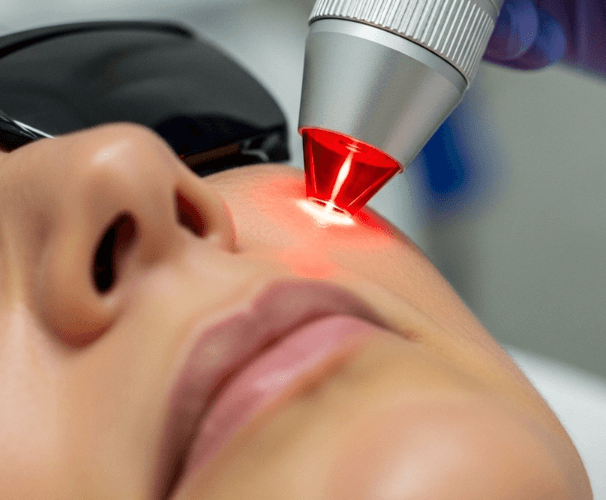Treatment Overview
The Q-Switched Ruby Laser operates at a 694 nm wavelength, one of the most effective for melanin absorption. It delivers high-intensity nanosecond pulses that selectively shatter melanin clusters without significantly harming surrounding skin.
In Korea, the Q-Switched Ruby Laser is frequently chosen for congenital and acquired pigmented birthmarks, particularly café-au-lait spots, Ota nevus, Mongolian spots, and other stubborn pigmented lesions. It is also widely used for tattoo removal (green, blue, and dark pigments) that are resistant to other lasers. Due to its strong melanin absorption, it is highly effective for resistant or deeply pigmented birthmarks, especially in lighter Asian skin tones.
It belongs to the Birthmark & Pigmentation Laser family (Q-Switched Ruby, Nd:YAG, Alexandrite, Pico, CO₂ Fractional, IPL):
- Q-Switched Ruby (694 nm): Best for resistant pigmented birthmarks + colored tattoos.
- Nd:YAG (1064/532 nm): Best for dermal pigment (Ota nevus, congenital nevi).
- Alexandrite (755 nm): Best for congenital café-au-lait and pigmented lesions.
- Pico Lasers: Best for stubborn pigmentation + scars + tattoos.
- CO₂ Fractional: Best for superficial pigmented lesions + textural irregularities.
- IPL: Best for vascular + superficial pigment.
Purpose & Benefits
- Birthmark Clearance: Effective for café-au-lait spots, Ota nevus, Mongolian spots, and congenital nevi.
- Pigmentation Reduction: Removes freckles, age spots, and stubborn pigmentation.
- Tattoo Removal: Particularly strong for green, blue, and dark tattoo inks.
- High Precision: Selectively targets melanin for deep clearance.
- Non-Invasive: Minimal damage to surrounding skin.
Ideal Candidates
Q-Switched Ruby Laser in Korea is recommended for:
- Children and adults with congenital pigmented birthmarks.
- Patients with resistant pigmentation (Ota nevus, Mongolian spots, café-au-lait).
- Individuals needing tattoo removal in resistant colors.
- Men and women comparing treatments:
- Ruby: Best for resistant pigmented birthmarks + tattoos.
- Nd:YAG: Best for dermal pigment + melasma + congenital marks.
- Alexandrite: Best for congenital pigmented lesions.
- Pico Lasers: Best for stubborn pigmentation + textural issues.
- CO₂ Fractional: Best for surface pigment + scarring.
- IPL: Best for superficial vascular + pigment.
Possible Risks & Complications
The Q-Switched Ruby Laser is safe but carries slightly higher PIH (post-inflammatory hyperpigmentation) risk in darker Asian skin. Temporary side effects may include:
- Redness & Swelling: Mild, lasts hours to 1–2 days.
- Crusting & Scabbing: Pigment rises to the surface and flakes off.
- Temporary Darkening: Birthmarks may darken before fading.
- Rare Risks: PIH, hypopigmentation, mottling, or scarring (minimized in Korean expert clinics).
Surgical Techniques Used
The Ruby Laser uses 694 nm nanosecond pulses for pigment fragmentation:
- 694 nm Wavelength: Strong melanin absorption for pigmented birthmarks.
- Q-Switched Mode: Delivers ultra-short pulses to shatter pigment.
- Protocol:
- Birthmarks: 3–8 sessions spaced 4–6 weeks apart.
- Resistant pigmentation: May require more sessions.
- Tattoos: 6–10 sessions depending on color and depth.
Recovery & Aftercare
- Immediately: Redness, mild swelling, or warmth.
- 2–3 Days: Scabbing or pigment darkening.
- 1–2 Weeks: Pigmented lesions lighten as scabs fall away.
Aftercare Tips:
- Apply soothing ointments as prescribed.
- Use SPF 50+ sunscreen daily to protect results.
- Avoid picking at scabs or crusts.
- Avoid retinoids, acids, or scrubs for 1–2 weeks.
Results & Longevity
- After First Session: Pigment darkens, then gradually lightens.
- Short-Term (2–4 Sessions): Noticeable fading of pigmented birthmarks.
- Medium-Term (4–8 Sessions): Significant clearance of congenital lesions.
- Long-Term: Many results are permanent, though resistant pigment may need maintenance.
Treatment Process in Korea
- Consultation & Skin Analysis – Doctor evaluates birthmark type, pigment depth, and size.
- Preparation – Cleansing, numbing cream (if needed), protective eyewear.
- Ruby Laser Session – 694 nm nanosecond pulses applied to target pigment.
- Post-Care: Cooling gel, healing ointments, or antioxidant infusions.
- Follow-Up: Multi-session plan for congenital or resistant pigment.
Why Korea is a Top Destination
- Korea uses latest-generation Q-Switched Ruby Lasers with high safety profiles.
- Dermatologists are skilled in treating congenital pigmentation in Asian skin.
- Affordable compared to Western clinics.
- Clinics often combine Ruby with Pico or Nd:YAG lasers for resistant cases.
- Seoul is internationally recognized for birthmark and pigment lesion expertise.
Cost Range (Detailed Breakdown)
Pricing for Q-Switched Ruby Laser in Korea:
- Small Birthmark (per session): USD 200 – 400
- Medium to Large Birthmark (per session): USD 400 – 800
- 3–8 Session Package: USD 1,200 – 3,500
Additional Costs in Korea:
- Consultation: USD 20 – 50
- Add-ons (Rejuran, exosomes, whitening drips): USD 100 – 400
💡 The Q-Switched Ruby Laser is often called “the stubborn pigment eraser” in Korea, due to its unmatched ability to treat deep, resistant congenital birthmarks and colored tattoos.
Popular Clinics
- Banobagi Dermatology (Seoul): Ruby for café-au-lait and resistant congenital marks.
- Oracle Dermatology (Seoul): Ruby + Nd:YAG protocols for Ota nevus.
- Renewme Skin Clinic (Seoul): Ruby + Pico combo for stubborn pigmentation.
- View Plastic & Dermatology (Seoul): Ruby for congenital and acquired pigmented lesions.
- Chaum Anti-Aging Center (Seoul): Premium Ruby Laser with regenerative boosters.




